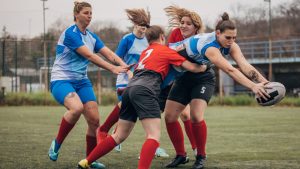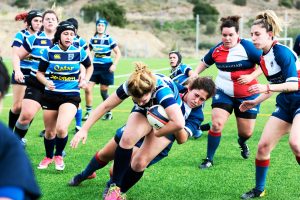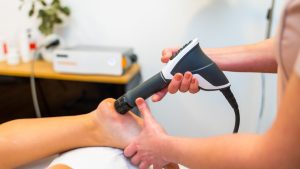Hard court tennis presents a unique physical challenge. The US Open in New York is one of the most demanding events on the calendar. The combination of the competitive field, intense heat and humidity, and the unforgiving nature of the surface places extreme demands on players’ bodies.
Hard courts are rigid and transmit greater impact forces to the body compared to clay or grass (1). Players on hard courts generate higher ball speeds, perform more aggressive rallies, and move at faster average speeds than on other surfaces (2).
Recent research on recreational players also highlights that hard courts are associated with a higher prevalence of lower limb overuse injuries compared to other surfaces, even though overall injury rates do not differ significantly between surfaces (3). This reinforces the need for surface-specific conditioning.
How the US Open Pushes Players Physically
Preparation for hard court tennis must be highly targeted. Key physical demands include:
- The consistent, high bounce encourages aggressive, powerful rallies (2)
- Players must repeatedly accelerate, decelerate, and change direction on a rigid surface (2)
- The impact forces are greater, increasing cumulative load on joints and muscles (1)
- The heat and humidity of late summer in New York can cause rapid fatigue and dehydration
Reid et al. (2016) found that both men and women at Grand Slam hard court events cover distances of approximately 550 to 575 metres per set, with male players moving at significantly higher mean speeds than on other surfaces (2). These findings underline the need for careful physical preparation.
Key Strength and Conditioning for Hard Courts
Lower Body Power and Endurance
Quadriceps and Hamstring Strength
Barbell Squats
- Stand with feet shoulder-width apart, barbell across the upper back
- Lower into a squat until thighs are parallel to the floor, keeping knees aligned over toes
- Push back up through the heels
- Perform 8 to 10 repetitions
- Complete 3 sets
Lateral Lunges
- Step out wide to the side, bending the leading knee while keeping the other leg straight
- Push back to the starting position
- Perform 8 to 10 repetitions per side
- Complete 3 sets
Plyometric Training for Explosiveness
Depth Jumps
- Stand on a low box or step
- Step off the box, land softly, then immediately jump vertically as high as possible
- Land softly and reset
- Perform 6 to 8 repetitions
- Complete 3 sets
Skater Jumps
- Start in a single-leg squat position on one leg
- Jump laterally to land on the opposite leg, maintaining balance
- Repeat side to side
- Perform 10 repetitions per side
- Complete 3 sets
Heat and Humidity: Managing Recovery and Hydration
- The US Open is known for extreme weather conditions. Studies show that surface stiffness combined with heat increases physiological stress on the body (1). Players must prepare to manage heat stress through:
- Structured heat acclimation during training weeks
- High-intensity interval training with limited rest periods
- Hydration protocols with electrolyte monitoring
- Cooling strategies such as ice towels and pre-match cooling garments
- Post-match recovery with ice baths, massage, and compression garments
Injury Risks on Hard Surfaces and How to Prevent Them
Dragoo (2010) highlighted that hard courts are associated with higher injury rates, particularly for overuse injuries of the lower limbs and spine (1). This is supported by Babette et al. (2016), who found that lower limb overuse injuries were more prevalent on hard courts than on other surfaces among recreational players (3).
Common risks on hard courts include:
- Knee injuries from deceleration and impact forces
- Hip and groin strains from rapid change of direction
- Lower back strain from repetitive loading and rotational forces
- Ankle sprains from abrupt cutting and pushing off
Injury prevention focus:
- Build eccentric quadriceps and hamstring strength
- Increase hip and groin mobility and strength
- Maintain a structured core stability programme
- Progressively load ankles with single-leg balance and plyometric drills
Players who frequently switch surfaces, for example in preparation for the US hard court swing, should take particular care. Babette et al. (2016) showed that players transitioning between multiple surfaces had a higher injury prevalence (3). Periodising training to allow for adaptation is therefore important.
2025 Hard Court Training Innovations
Many top players now integrate the following into their hard-court preparation:
- Force plate testing to optimise landing mechanics
- Velocity-based training to fine-tune power output
- Wearable monitoring of training loads and recovery
- Sport-specific conditioning circuits that mimic match-play intensity
- Data-driven hydration and nutrition strategies
Even recreational players can benefit from structured plyometric work, proper hydration, and recovery protocols to handle the intensity of hard-court tennis.
How Hard Court Tennis Builds Mental Toughness
Beyond the physical demands, hard court tennis requires mental resilience. Players must handle:
- The cumulative fatigue of repeated high-impact rallies
- The physical discomfort of heat and surface stress (1)
- The need to stay focused and execute technically sound shots under fatigue
Reid et al. (2016) showed that players adapt their stroke patterns and positioning to cope with faster rally tempos and more aggressive court positioning on hard courts (2). Simulated match drills under fatigue can help players develop this mental edge.
Final Thoughts
Hard court tennis, particularly at the US Open, tests every aspect of a player’s physical and mental game. To perform at your best, a carefully structured fitness and injury prevention programme is essential.
Use these tips to build explosive power, manage fatigue, and stay injury-free on hard courts. The preparation you do now will pay dividends deep into the tournament.
Next in the series: How to Prepare for Tennis in Extreme Heat: Australian Open Fitness and Recovery Guide.
References:
- Dragoo JL, Braun HJ. The Effect of Playing Surface on Injury Rate: A Review of the Current Literature. Sports Med. 2010;40(11):981-990.
- Reid M, Morgan S, Whiteside D. Matchplay characteristics of Grand Slam tennis: implications for training and conditioning. J Sports Sci. 2016;34(19):1791-1798.
- Pluim BM, Clarsen B, Verhagen E. Injury rates in recreational tennis players do not differ between different playing surfaces. Br J Sports Med. 2018;52(611-615).




